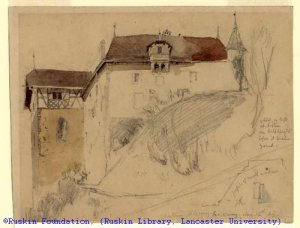The Visual And The Verbal by Anna Burton
Click here to go to the films of the students’ presentations
‘The Visual and the Verbal’: Ruskin and Chateau Blonay.
Anna Burton
University of Liverpool
Chateau Blonay, near Vevay, Switzerland, 12th August 1846. This drawing was placed in front of me at ‘The Visual and the Verbal’ event at Lancaster, as part of a hands on session with the Ruskin archives. We each had to read our prospective drawings for what they revealed about Ruskin’s style and compositional technique, and perhaps more importantly, what questions these images posed on an initial view. Ruskin’s Chateau Blonay as a drawing is very much a working progress, but in its unfinished state it is particularly revealing. The minute detail of the latticed window in the top left hand corner, descends diagonally into a chaotic impression of the scene. In fact, the visual image descends into verbal annotation, planned additions and alterations, preliminary corrections for the subsequent work on the drawing that never materialised. This is certainly not a criticism, I found Ruskin’s drawing more interesting in its incomplete state; in a view of the drawing, the observer witnesses Ruskin’s method, and can trace his thoughts across the compositional space of the image. The visual gaps invite an imaginative scrutiny, and hopefully without sounding too pretentious or grandiose, I would argue that the image serves as a suitable visual metaphor for the training day itself.
The close physical and notional proximity between the Visual and the Verbal served as the focus point for the whole event. We each individually gave a brief presentation on how our research deals with multiple disciplines, how it engages with forms of visual art and consequently, how we each approached the overall theme within our own specific field of interest. This resulted in an introduction to vastly differing research practices, but at times illuminated interconnected threads of concurrent discourse going on amongst our individual projects.Throughout the day, we handled and transcribed archival materials and discussed the problems, pleasures and pit falls of dealing with the sister arts as a coeval concern. Just as we were each presented with a different drawing to focus on, we evidently each have our own personalised lines of enquiry; what the Visual and the Verbal event brought to light is that as a research approach, it allows for interdisciplinary engagement between these projects and perspectives. It would certainly be fascinating to see how these individual projects develop,whether there would be any more similarities between these discourses when they are fully realised, and perhaps how our own approaches to the Visual and Verbal change across our individual research projects. Moreover, it would be interesting to see how our own perspectives have developed as a result of the training day itself. Whether, like the Visual and Verbal gaps in Ruskin’s drawing, the view of our research becomes more defined across the spatial and temporal composition of our own work.


0 Comments